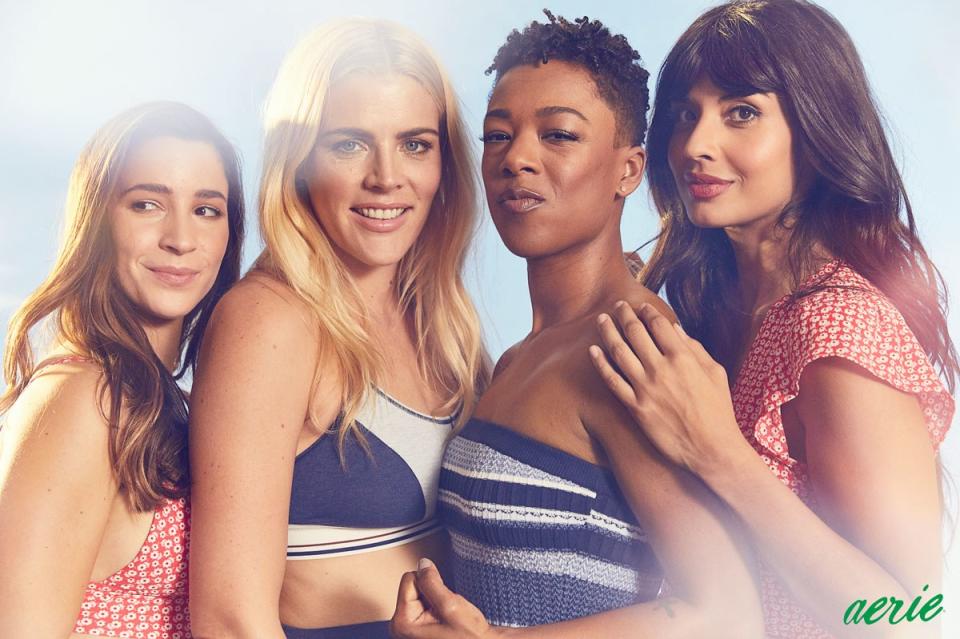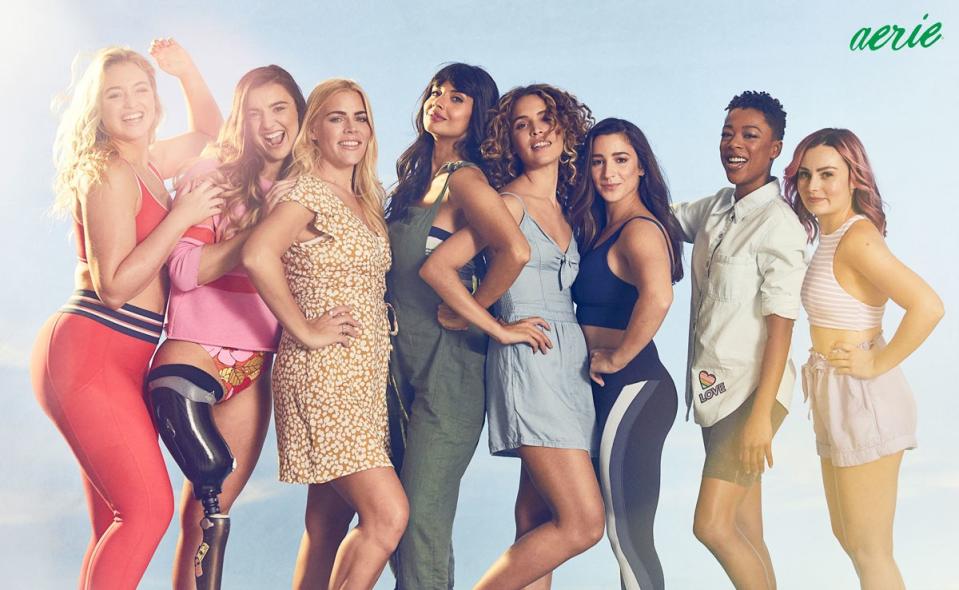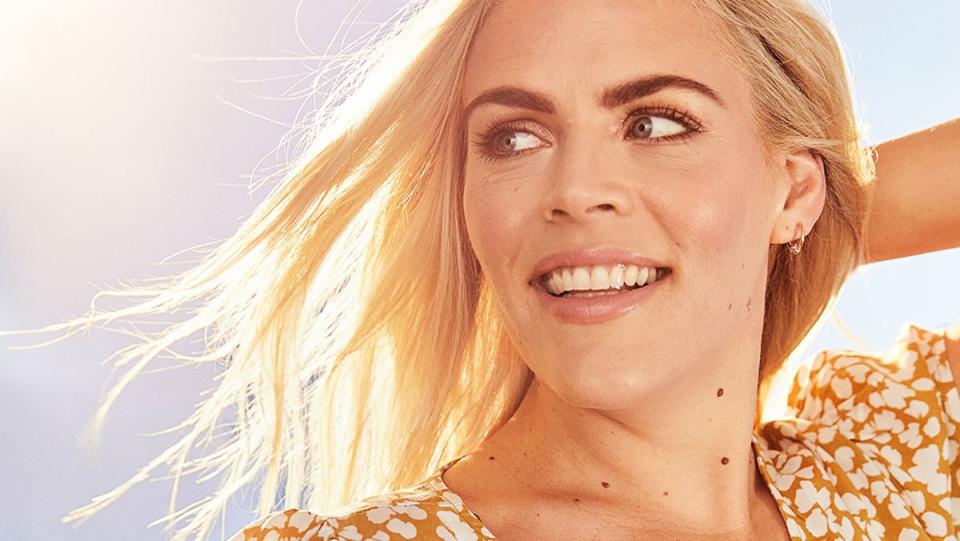Everything Busy Philipps Does Is About Smashing the Patriarchy
The defining characteristic of Aerie’s campaigns is their commitment to portraying a group of diverse women as they are: with no retouching, allowing them to present the most authentic version of themselves in their intimates (which is one of the most personal items of clothing, after all). Its spokespeople aren’t called “stars” but rather Role Models. They include the likes of Iskra Lawrence, Aly Raisman, Yara Shahidi—and now Busy Philipps.
If you've followed her on Instagram (which, uh, you really should), read her memoir, tuned into her late-night show, or kept up with her two-decade career in Hollywood, you know Philipps has always kept it real. That makes her an obvious fit for the whole #AerieReal message. Philipps says the partnership “is actually such a huge deal for me,” and much bigger than just getting to appear in some ads—it's about endorsing the brand's underlying philosophy of representing women and celebrating their diversity. (Aerie stopped retouching its models in 2014, a decision that had an immediate effect not only on its parent company’s sales but also on the advertising industry at large.)
The actress remembers noticing the brand's #AerieReal efforts a few years ago—she was walking down a street in New York City and was impressed by a billboard featuring models of different shapes and sizes. “I remember seeing those [Aerie] ads and feeling like, That is so dope. That is so cool. Those women are beautiful and look incredible,” she tells Glamour. “I loved it. It made me so happy to see.”

“I’m the mom of two little girls—one daughter, Birdie, is 10 years old now, and I have already seen the influence that magazines and ads and seeing different types of humans and bodies [has] had on her,” Philipps says. "Aerie taking this position of no retouching and being one of the first companies to do so is so powerful and has had such an impact. And hopefully, it’s going to change a lot of industry standards for others.”
Philipps came up in the heyday of the “Nothing comes between me and my Calvins” campaigns of the nineties. Even to this day, she feels insecure about parts of her body. “My stomach didn’t look like Kate Moss’s stomach when I was a preteen and a teenager," she says. "It was the thing that has been the hardest for me to overcome, that programming.”
Even as supermodels like Emme started to come up later in the decade and the industry began slowly introducing plus-size bodies into its imagery, Philipps still didn’t see the in-between space she occupied—not sample-size, not plus-size—represented. “I’ve got hips and a butt and boobs, but where do I see what [something] looks like on me?” she says. That’s where Aerie has been a game changer for online shoppers like her, she adds, “[using] women of all different shapes and sizes, not just the two that we were accustomed to for so many years.”

On top of appearing in Aerie’s campaigns, Philipps now wears the title of Role Model for the brand. (Other new members of the class: Samira Wiley, Jameela Jamil, Brenna Huckaby, and Molly Burke.) If you know her work, you know the multihyphenate surrounds herself with a lot of incredibly strong women, from Tina Fey (who executive-produces Busy Tonight) to longtime agent Lorrie Bartlett (who became the first African American woman to join the board of a major Hollywood talent agency in January). One of the most important ones, though, has been her mom. “I mean, obviously, a lot of people say their mother, but my mom is an incredibly strong woman and one of my role models," she says. "That’s why I dedicated my book to her and really why I feel my book was a love letter to my mother and how unwavering she always was in her support and love of me.”
Even before this, though, Philipps has gained fans for her candor in speaking on topics ranging from her workout routine to the ups and downs of her career. “I think that's why people have responded [to my Instagram presence], because I've tried to show a very realistic balance of my life,” she says. “I feel like what I try to put forth is honesty and sharing myself in the hopes that it will or could help someone else, because I’m at a point in my life—I’m 39 years old—where, if I don’t share these stories and share my life in this way, what’s the point of any of it? What was the point of me going through any of it?”
The attention for her social media is nice. But what really makes it all worth it for Philipps is the way people connect with her work and take something from it. For instance: “A girl came up to me on the street—I had just gotten coffee—and she goes, ‘I just finished your book and I just can’t tell you how grateful I am that I read it. I felt so alone in some of the things that I’ve gone through and to read that you went through it meant the world to me,’” she says. “And honestly, that’s the only reason I wanted to write the book. It was for that interaction, for that girl.” Philipps says she's had more moments like this, and it's helped her feel she has a tribe behind her.
“We’ve seen what social media can be at its most annoying and kind of its worst," she continues, "but I do think that there’s a real opportunity to build a sense of community. Building a sense of community with younger women is very important to me and something that I think we can only use more of."
This is what underlies all of her work, Philipps adds: "All the kinds of, for lack of a better word, content that I put into the world, whether it’s my talk show or my book or my Instagram feed or my Aerie partnership, [I ask myself], How does this continue to help other women, support a community of women, and ultimately, truthfully, bash the patriarchy into the ground?”


